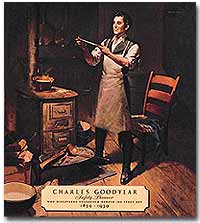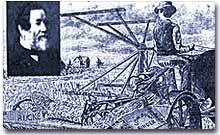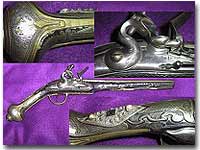25c. Inventors and Inventions

Charles Goodyear received a patent for developing a method of treating rubber, called vulcanization
A nation becomes great because of great people. Often the people that make the greatest impact on progress are not national leaders, but brilliant men and women of ideas. A handful of individuals developed inventions in the first half of the nineteenth century that, not only had a direct impact on everyone's lives, but also affected the destiny of the American nation.
In the second decade of the nineteenth century, roads were few and poor. Getting to the frontier and instituting trade with settlers was difficult. In 1807, Robert Fulton sailed the first commercially viable steamboat, the Clermont, from New York City to Albany. Within 4 years, regular steamboat service from Pittsburgh took passengers and cargo down the Ohio into the Mississippi. Within 20 years, over 200 steamboats were plying these routes.
While New England was moving to mechanize manufacturing, others were working to mechanize agriculture. Cyrus McCormick wanted to design equipment that would simplify farmers' work. In 1831, he invented a horse-drawn reaper to harvest grain and started selling it to others in 1840. It allowed the farmer to do five times the amount of harvesting in a day than they could by hand using a scythe. By 1851, his company was the largest producer of farm equipment in the world.

Cyrus McCormick's reaper was five times more efficient than hand harvesting wheat, but at first farmers looked upon the invention as a novelty.
In 1837, John Deere made the first commercially successful riding plow. Deere's steel plow allowed farmers to turn heavy, gummy prairie sod easily, which stuck to the older wooden and iron plows. His inventions made farm much less physically demanding. During the Civil War, 25 years later, even women and young children of the South would use these devices allowing the men to be away at war.
Another notable American inventor was Samuel F.B. Morse, who invented the electric telegraph and Morse Code. Morse was an artist having a great deal of difficulty making enough money to make ends meet. He started pursuing a number of business opportunities which would allow him to continue his work as an artist. Out of these efforts came the telegraph. With the completion of the first telegraph line between Baltimore and Washington in 1844, almost instant communication between distant places in the country was possible. The man who was responsible for building this first telegraph line was Ezra Cornell, later the founder of Cornell University.

Until Eli Whitney invented interchangeable parts, pistols like this one were handcrafted by gunsmiths, one at a time.
Charles Goodyear invented one of the most important chemical processes of the century. Natural rubber is brittle when cold and sticky when warm. In 1844, Goodyear received a patent for developing a method of treating rubber, called vulcanization, that made it strong and supple when hot or cold. Although, the process was instrumental in the development of tires used on bicycles and automobiles, the fruit of this technology came too late for Goodyear. He died a poor man.
Perhaps no one had as great an impact on the development of the industrial north as Eli Whitney. Whitney raised eyebrows when he walked into the US Patent office, took apart ten guns, and reassembled them mixing the parts of each gun. Whitney lived in an age where an artisan would handcraft each part of every gun. No two products were quite the same. Whitney's milling machine allowed workers to cut metal objects in an identical fashion, making interchangeable parts. It was the start of the concept of mass production. Over the course of time, the device and Whitney's techniques were used to make many others products. Elias Howe used it to make the first workable sewing machine in 1846. Clockmakers used it to make metal gears. In making the cotton gin, Eli Whitney had played a major part in expanding slavery. In making the milling machine to produce precision guns and rifles in a very efficient and effective way, he set the industrial forces of the North in motion.






